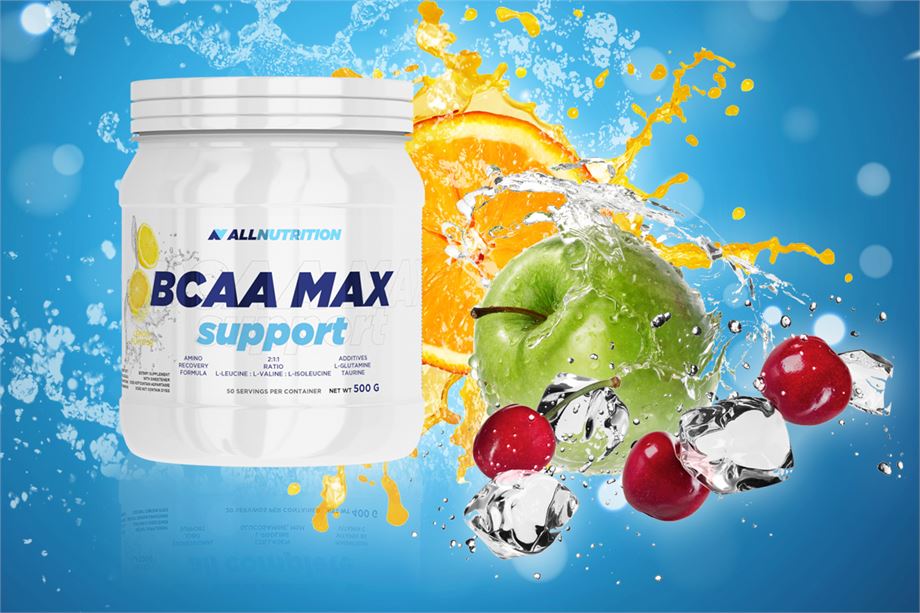Głownie jako doskonały antykatabolik
https://www.sfd.pl/BCAA_branched_chained_amino_acids__jako_antykatabolik_-t711768.html
Dlaczego?
Około 35% mięśni składa się z BCAA
BCAA wykorzystywane są bezpośrednio w mięśniach.
Dodatkowe porcje BCAA, podane przed treningiem i po jego zakończeniu, zostaną wprzęgnięte w cykl glukozowo-alaninowy i zahamują rozpad (katabolizm) białek.
............ale o tym juz bylo.
Nalezy rowniez pamietac o tym ze bcaa ograniczaja/hamuja katabolizm bialek miesniowych
pamietamy tez ze leucyna jest aminokwasem 'kluczem' która nasila synteze
https://www.sfd.pl/Leucyna__stymuluje_syntezę_białek_i_reguluje_poziom_cukru-t695397.html
ale musimy pamietac tez o tym ze - aby nastapila synteza potrezbne sa wszystkie EAA - aminokwasy egzogenne - nie tylko bcaa,tymbardziej nie sama leucyna!
https://www.sfd.pl/Synteza_białek_mięsniowych_anabolizm__EAA_vs_NEAA-t721412.html
Tak wiec BCAA przed treningiem - jak najbardziej
BCAA na treningu - jak najbardziej
BCAA po treningu - juz nie koniecznie!
dlaczego nie?
poniewaz potrzebne sa wszystkie EAA - nie tylko leucyna,izoleucyna i walina!
......ale o tym juz bylo.
O tym ze BCAA sa doskonalym antykatabolikime tez - teraz troche z innej beczki:
BCAA a redukcja tkanki tluszczowej!

Higher branched-chain amino acid intake is associated with a lower prevalence of being overweight or obese in middle-aged East Asian and Western adults.
Beneficial effects on body weight of supplementation with BCAA, including leucine, isoleucine, and valine, have been observed in animal and human studies. However, population-based studies on dietary BCAA intake and body weight are lacking. The objective of this study was to examine the association between dietary BCAA intake and risk of overweight status/obesity among multi-ethnic populations. The International Study of Macro-/Micronutrients and Blood Pressure is a cross-sectional epidemiological investigation in China, Japan, the UK, and the US. The study cohort included 4429 men and women ages 40-59 y who were free of diabetes. Diet was assessed by 4 multi-pass 24-h recalls; data on nutrients including BCAA were derived from country-specific food tables. Overweight status and obesity were defined as BMI ? 25 and BMI ? 30 kg/m(2), respectively. Multivariable-adjusted OR of overweight status/obesity and 95% CI by quartiles of BCAA intake were estimated by logistic regression. Mean BCAA intake was 2.6 ± 0.6% energy; intake was significantly lower among Chinese participants and similar among participants from the other 3 countries. Compared with those in the first quartile, the multivariable-adjusted OR (95% CI) of overweight status from the 2nd to 4th quartiles of BCAA intake were 0.97 (0.80-1.17), 0.91 (0.75-1.11), and 0.70 (0.57-0.86), respectively (P-trend < 0.01). BCAA intake and obesity were also inversely associated (P-trend = 0.03). In conclusion, higher dietary BCAA intake is associated with lower prevalence of overweight status/obesity among apparently healthy middle-aged adults from East Asian and Western countries.
http://www.ncbi.nlm.nih.gov/pubmed/21169225
krotko i na temat:
badano ilosc spozycia BCAA w 4 krajach (Chiny,Japonia,UK,USA) a ilosc osob otylych
wnioski:
ilosc spozytego BCAA w ich dietach jest odwrotnie proporcjonalna do otylosci
czyli im wiecej spozytego BCAA - tym mniejszy odsetek ludzi otylych!
*******************
Ponizsze badanie przewija sie w kazdym watku dotyczacym bcaa a redukcji - wiec i ja nie omieszkam strescic tego badania:
Combined effects of caloric restriction and branched-chain amino acid supplementation on body composition and exercise performance in elite wrestlers.
Twenty-five competitive wrestlers restricted their caloric intake (28 kcal.kg-1.day-1) for 19 days, using a hypocaloric control (hC, n = 6), hypocaloric high-protein (hHP, n = 7), hypocaloric high-branched-chain amino acid (hBCAA, n = 6), hypocaloric low-protein (hLP, n = 6) diet to determine the effects of caloric restriction on body composition and performances versus control diet (C, n = 6). Anthropometric parameters (weight, percent body fat) and adipose tissue (AT) distribution measured by magnetic resonance imaging (MRI) obtained before and after diet, were compared. A significant highest body weight loss (-4 kg, p < 0.05) and decrease in the percent of body fat (-17.3%, p < 0.05) were observed for subjects of the hBCAA group. Subjects of the hBCAA group exhibited a significant reduction (-34.4%, p < 0.05) in abdominal visceral adipose tissue (VAT). There was no change in aerobic (VO2max) (p > 0.75) and anaerobic capacities (Wingate test) (p > 0.81), and in muscular strength (p > 0.82). We conclude that under our experimental conditions, the combination of moderate energy restriction and BCAA supplementation induced significant and preferential losses of VAT, and allowed maintainance of a high level of performance
http://www.ncbi.nlm.nih.gov/pubmed/9059905
przez 19 dni 25 wrestlerow zostalo podzielone na 4 grupy ,ktorych wspolnym mianownikiem byla dieta redukcyjna (minusowy bilans)
-controlna (hC)
-duzo bialka (hHP)
-duzo BCAA (hBCAA)
-malo bialka (hLP)
wnioski:
-najwiecej 'spalila' grupa hBCAA tracac -4kg wagi i az -17.3% BF
-rowniez najwiecej stacila porownujac tluszcz brzuszny -34.4%
Co może byc tego przyczyna?
Podczas spozycia dodatkowego bcaa w postaci suplementu - poziom tych aminokwasów we krwi wzrasta.
Jesli wzrasta w normalnych warunkach to o czym swiadczy?
O wzroscie katabolizmu!
(brak energi - rozkladane sa bcaa w celu pozyskanie energi)
wiec jesli pojawiaja sie we krwi bcaa - ale tym razem nie koniecznie 'nasze' - to daje sygnal organizmowi ze za duzo miesni jest traconych wiec wzrasta zuzycie fatu.
Kolejna teoria jest taka ze leucyna stymuluje leptyne - hormon ktory informuje o ilosci tkanki tluszczowej,o ilosci spozytej energi.
Im więcej tkanki tłuszczowej, tym więcej wytwarzanej leptyny, która informuje mózg o ilości rezerwowych zasobów energii.
Jeżeli jest jej dużo, oznacza to że mózg powinien wyłączyć uczucie głodu i spalać tłuszcz.
Wiec im wiecej leptyny - tym lepiej ,bo teoretycznie wiecej tluszczu powinno byc spalane.
(w okresie stosowania diety redukcyjnej - dlugotrwalej - w komórkach tłuszczowych stężenie leptyny gwałtownie spada, co może być przyczyną trudności w odchudzaniu.)
Leucine in food mediates some of the postprandial rise in plasma leptin concentrations.
In vitro, leptin secretion is regulated at the level of mRNA translation by the rapamycin-sensitive mammalian target of rapamycin (mTOR) and its agonist leucine (Leu). Studies were conducted on meal-trained rats to evaluate the potential physiological relevance of these in vitro findings and the role of Leu in affecting rises in plasma leptin observed after a meal. In the first study, we correlated changes in plasma insulin and Leu to mTOR-signaling pathway activation and plasma leptin at different times during meal feeding. Rapid rises in plasma insulin and Leu, along with mTOR signaling (phosphorylation of eIF4G, S6K1, rpS6, and 4E-BP1) in adipose tissue were observed during the 3-h meal and declined thereafter. Plasma leptin rose more slowly, peaking at 3 h, and was inhibited by rapamycin (0.75 mg/kg) pretreatment. In another experiment, oral Leu or norleucine was provided instead of a meal. Leu and norleucine stimulated a rise in plasma leptin; however, the magnitude was less than the response to a complete meal. In a third study, rats were provided a meal that lacked Leu, branched-chain amino acids, or all amino acids. Stimulation of leptin secretion was reduced approximately 40% in animals provided the Leu-deficient meal. Further reductions were not observed by removing the other amino acids. Thus Leu appears to regulate most of the effects of dietary amino acids on the postprandial rise in plasma leptin but is responsible only for part of the leptin response to meal feeding.
http://www.ncbi.nlm.nih.gov/pubmed/16638821
-leucyna wydaje sie byc aminokwasem ktory ma najwiekszy wplyw na poziom leptyny
-spozywanie posilku bez leucyny powoduje mniejszy poziom leptyny o ~40%
-usuwanie kolejnych aminokwasow nie wywiera juz zadnego wplywu
Tak wiec leucyna wywiera najwiekszy wplyw wsrod aminokwasow na poziom leptyny - ale co wazne nie tylko ona decyduje o poziomie leptyny na skutek spozytego posilku!
Effects of leucine supplementation on the body composition and protein status of rats submitted to food restriction.
Acute administration of leucine has been shown to stimulate certain protein synthesis related anabolic processes. However, the effect of chronic leucine administration in a catabolic situation caused by food restriction (FR) has not been established. We therefore evaluated the effect of chronic leucine supplementation on the body composition and some indicators of protein nutritional status of rats submitted to FR.
METHODS:
Adult male Wistar rats were submitted to 50% FR for 6 weeks. The control group received the AIN-93M diet and the leucine group received the same diet supplemented with 5.91 g L-leucine/kg ration. We then determined carcass chemical composition, serum leptin, albumin and total protein concentrations, and protein, DNA and RNA concentrations in gastrocnemius muscle and liver.
RESULTS:
No difference in final body weight was observed between groups. However, the leucine group presented a lower amount of body fat (P < 0.05). Leptin concentration showed a directly proportional correlation with the amount of body fat (r = 0.88, P < 0.05), but no significant difference in serum leptin concentration was observed between groups (P = 0.08). Regarding protein nutritional status, liver protein concentration was higher in the leucine group (P < 0.05). In the gastrocnemius muscle, a higher RNA concentration (P < 0.05) and a tendency towards higher DNA concentration (P = 0.06) were observed in the leucine group.
CONCLUSION:
The results indicate that low-dose leucine supplementation increases body fat loss and improves liver protein status and the capacity of muscle protein synthesis in rats submitted to FR.
http://www.ncbi.nlm.nih.gov/pubmed/16600817?dopt=Abstract
badano wplyw diety restryckyjnej (50%) na szczury
jednej grupie podano diete + leucyna w ilosci 5,91g/kg
-waga nie roznila sie zbytnio pomiedzy grupami
ale
-grupa spozywajaca leucyne miala mniejszy poziom tkanki tluszczowej
-grupa spozywajaca leucyne miala wieksza zawartosc bialka w watrobie
-grupa spozywajaca leucyne miala wieksza zdolnosc do syntezy bialek miesniowych
Ale nie tylko sama leucyna moze miec wplyw na utrate tkanki tluszczowej - rowniez izolecyna i walina:
Isoleucine prevents the accumulation of tissue triglycerides and upregulates the expression of PPARalpha and uncoupling protein in diet-induced obese mice.
In this study, we investigated the effects of the branched-chain amino acid l-isoleucine (Ile) on both obesity and glucose/fat homeostasis in mice that were fed a high-fat (45% energy) diet. The mice were divided into different treatment groups and given a high-fat diet for 6 wk. During the last 4 wk, Ile was dissolved and added to the drinking water to a final concentration of 2.5%. The control mice received vehicle alone. The mice in the Ile group had an almost 6% lower body weight gain and 49% less epididymal white adipose tissue (WAT) mass with the control group (P < 0.05). The hepatic and skeletal muscle triglyceride (TG) concentrations and degree of hyperinsulinemia in the Ile group mice were also lower than the control group by 38, 47, and 39%, respectively (P < 0.05). The WAT leptin concentration was also lower, whereas that of adiponectin was higher, in the Ile group compared with the control group (P < 0.05). The hepatic levels of protein CD36/fatty acid translocase, PPARalpha, and uncoupling protein (UCP) 2 and the levels of UCP3 in skeletal muscle were all greater in the Ile group than in the control mice (P < 0.05). These results demonstrate that the liver and muscle TG concentrations are both lowered by Ile treatment. In addition, the PPARalpha and UCP expression levels in the mouse tissues were greater in the Ile group compared with the controls. Our current data thus suggest that supplementation with Ile might be useful in the treatment of metabolic syndrome.
http://www.ncbi.nlm.nih.gov/pubmed/20089773
badano na szczurach diete high fat + wplyw izoleucyny
przez 6 tygodni szczury karmiono dieta wysokotluszczowa (45%)
na ostatnie 4 tygodnie podawano im w wodzie izoleucyne (2,5%)
-grupa spozywajaca izoleucynę miala o -6% mniejsza wage
-grupa spozywajaca izoleucynę miala o -49% mniej bialej tkanki tluszczowej (WAT)
-grupa spozywajaca izoleucynę miala o -38% mniejszy poizom trójlglicerydow w watrobie
-grupa spozywajaca izoleucynę miala o -47% mniejszy poizom trójlglicerydow w miesniach
-grupa spozywajaca izoleucynę miala o -39% mniejszy poziom insuliny
-grupa spozywajaca izoleucynę miala wiekszy poziom PPAR alfa w watrobie i miesniach, mniejszy w tkance tluszczowej
-grupa spozywajaca izoleucynę miala wiekszy poziom UCP2 w watrobie i tkance tluszczowej
-grupa spozywajaca izoleucynę miala wiekszy poziom UCP3 w miesniach
-grupa spozywajaca izoleucynę miala wiekszy poziom adiponektyny w tkance tluszczowej
UCP - Białka rozprzęgające (uncoupling protein) -Opisano pięć izoform białek UCP w komórkach ssaków: UCP1, UCP2, UCP3, UCP4 oraz BMCP, występujące w mózgu. Główną ich funkcją jest tworzenie ciepła poprzez rozprzęganie fosforylacji oksydatywnej. Białko UCP2 występuje powszechnie w tkankach ssaków.
Odgrywa ono kluczową rolę w procesie termogenezy.
ADIPONEKTYNA-niskie stężenie adiponektyny w surowicy krwi jest ściśle związane z insulinoopornością i zespołem metabolicznym, zwiększonym ryzykiem rozwoju cukrzycy typu 2 oraz chorób sercowo-naczyniowych.
Wysoki poziom adiponektyny korzystnie wpływa na spalanie tkanki tłuszczowej.
Działa jako endogenny czynnik uwrażliwiający na insulinę; obniża on podwyższony poziom glukozy bez wzrostu stężenia insuliny. Adiponektyna stymuluje między innymi spalanie ekotopowej tkanki tłuszczowej, zwiększa wrażliwość tkanki mięśniowej i wątroby na insulinę, a tym samym poprawia insulinowrażliwość.
Dlatego adiponektyna jest odpowiednim biomarkerem insulinooporności - u osób z insulinoopornością stężenie adiponektyny w surowicy krwi jest znacznie mniejsz
Effect of valine on the control of fatty acid synthesis in white adipose tissue of the rat.
In adipocytes from fed rats, the rate of fatty acid synthesis in the presence of glucose and insulin was inhibited 40% by valine (5 mm). tthis inhibition was largely abolished by the addition to the incubation medium of the transaminase inhibitor aminooxy acetate, and of pyruvate and agents which raise the intracellular pyruvate levels such as N,N,N1,N1-tetramethyl-p-phenylenediamine. Pyruvate output into the incubation medium from fat pads obtained from fed rats and incubated with glucose and insulin was decreased significantly by the addition of valine. When adipocytes were incubated under similar conditions, the final concentration of pyruvate in the incubation medium was 42 +/- 1.6 muM under control conditions and approximately one third of this value in the presence of 2.5 mM valine. Valine had no significant effect on pyruvate dehydrogenase (lipoate) (EC 1.2.4.1) activity when assayed in homogenates prepared from adipose tissue previously incubated for 60 min with the amino acid. Although the ketoacid analogue of valine alpha-ketoisovaleric acid, is a competitive inhibitor of pyruvate dehydrogenase (lipoate) (K1 = 1.4 mM), this cannot solely account for the valine-induced reduced rate of lipogenesis. Rather, the mechanism involves a reduction in pyruvate concentration and thereby a diminished flow through pyruvate dehydrogenase (lipoate). Details of the possible mechanism are discussed.
http://www.ncbi.nlm.nih.gov/pubmed/1203753?dopt=Abstract
w komorkach tluszczowych szczurow (po karmieniu) synteza kwasow tluszczowych byla zahamowana o 40%
"Cóż jest trucizną?
Wszystko jest trucizną i nic nie jest trucizną, tylko dawka czyni, że dana substancja nie jest trucizną!".
BLOG: http://www.sfd.pl/t1033576.html


 Krzysztof Piekarz
Krzysztof Piekarz

 . I że carbo
. I że carbo  .
.



